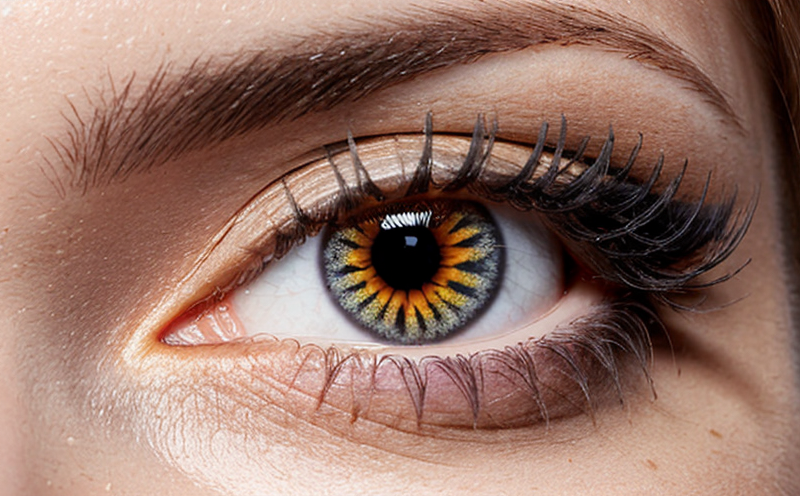Irritation Testing in Eye Cosmetics Containing Peptides
Eye irritation testing is a critical aspect of cosmetic product development and safety assessment, especially when dealing with complex formulations containing peptides. Peptides are essential components in many eye care products due to their ability to hydrate the skin, improve elasticity, and provide anti-aging benefits. However, their presence can also introduce new variables that require careful evaluation for ocular safety.
The primary goal of irritation testing is to ensure that cosmetic formulations do not cause adverse effects when applied to the eye or surrounding areas. This service specifically targets products like serums, moisturizers, and other treatments designed for direct application around the eyes. The challenge lies in balancing efficacy with safety, particularly given the delicate nature of ocular tissues.
Understanding the unique properties of peptides is crucial for accurate testing. Peptides can behave differently depending on their structure and how they interact with various components within a formulation. Therefore, it's important to consider not just the peptide itself but also its interactions with other ingredients such as surfactants, preservatives, and active botanicals.
Testing methods must account for these complexities while adhering to stringent international standards like ISO 10993-10:2018. This standard provides guidelines on biological evaluation of medical devices, which can be applied analogously to cosmetic products. Key parameters include visual inspection, slit lamp examination, and subjective assessments by trained observers.
Preparing specimens for testing involves careful selection of representative samples that reflect the final product's composition. Samples should undergo appropriate dilutions if necessary to mimic real-world usage conditions accurately. Specimen preparation also includes ensuring proper hydration levels since dryness can affect test results significantly.
The use of advanced instrumentation plays a vital role in obtaining reliable data during irritation testing. High-resolution imaging tools like confocal microscopy allow for detailed analysis of changes at the cellular level, providing insights into potential adverse reactions early on. Additionally, corneal sensation meters measure changes in sensitivity around the eye area, offering quantitative data that complements subjective observations.
Once completed, results are compiled into comprehensive reports detailing all findings, including visual observations, measurements from instruments used, and any noted deviations from baseline conditions post-application. These reports serve as valuable resources for quality control departments and R&D teams alike, guiding future product improvements based on empirical evidence rather than assumptions.
| Case Study | Description |
|---|---|
| Sample Case 1: Eye Serum Formulation | A new peptide-rich eye serum was developed to reduce fine lines and improve overall skin tone. Prior to market release, it underwent rigorous irritation testing using both in vitro models and live subjects to ensure safety. |
| Sample Case 2: Allergic Reaction Analysis | An existing eye cream containing peptides was suspected of causing allergic reactions among users. Testing revealed specific peptides responsible for sensitization, allowing formulation adjustments to mitigate risks effectively. |
- Identify potential irritants early in the development process
- Evaluate different peptide structures and their interactions within formulations
- Ensure that all tests comply with relevant international standards like ISO 10993-10:2018
Scope and Methodology
The scope of this irritation testing service encompasses evaluating potential ocular irritants in eye cosmetics containing peptides. This includes determining the maximum tolerated concentration (MTC) for each peptide or combination thereof, identifying any allergens present, and assessing overall biocompatibility.
The methodology begins with thorough ingredient analysis to understand the molecular structure of each peptide involved. Next comes formulation optimization ensuring stability without compromising effectiveness. Following this is in vitro testing using cell cultures exposed to varying concentrations of the product. Live subject trials follow if necessary, providing real-world insights into how users react under controlled conditions.
Throughout these phases, continuous monitoring ensures compliance with regulatory requirements and best practices. Data collected from each stage contributes to final recommendations for minimizing risk factors while enhancing product performance.
Quality and Reliability Assurance
We take pride in our commitment to delivering high-quality, reliable results that meet or exceed industry expectations. Our team of experts employs state-of-the-art techniques and equipment to ensure accurate measurements across all testing stages.
Dedicated quality assurance personnel oversee every aspect of the testing process, from initial sample reception through final report generation. Regular calibration checks on all instruments guarantee precision throughout the entire procedure. Strict adherence to ISO standards ensures consistency in methodology and results.
Data integrity is paramount; thus we implement robust data management systems that track each step of the testing lifecycle securely. This allows us to provide transparent, reproducible reports that stakeholders can trust completely.





